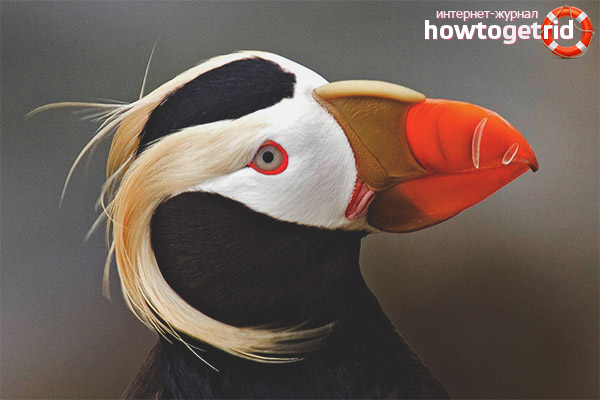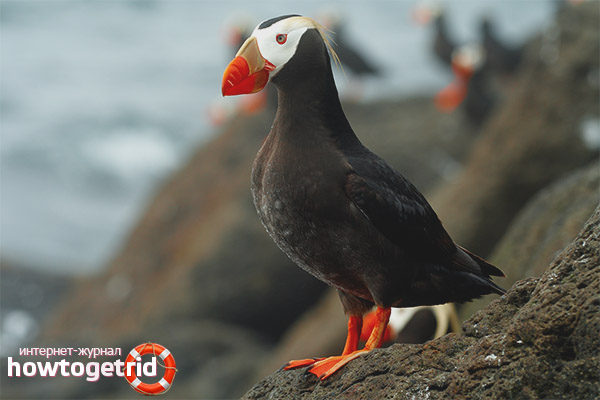The content of the article
The hatchet bird belongs to the purebred family. She has a very unusual appearance. Representatives of this species live mainly in the Arctic Ocean. Sometimes this bird is called a mortar. They live on rocks and small islands located near Kamchatka and Sakhalin.
Description
These birds are medium in size. The body has a length of about 38 cm. They weigh 580-800 g. The plumage is dark in color. The plumage is yellow only behind the eyes of the bird, and the cheeks are painted in contrasting white. The base of their head is also white. On the legs there are membranes. The legs are red. Young individuals have gray legs. A distinctive feature of birds of this species is the original orange beak. He is big and powerful, narrow. It was thanks to him that the species got its name. The chicks have a white abdomen, and their back is grayish. They fly perfectly, but at the same time it is rather difficult for a bird to fly from the water. To do this, they accelerate for a long time. Hatchets can fly high. In addition, they dive and swim perfectly. When running, they rely on fingers.
Nutrition
Since the bird is relatively large, it needs an appropriate amount of food. The main diet is fish and various invertebrates. They get their food very unusual. They dive and chase their victims underwater. Their wings are designed to allow the bird to swim well. In water, she feels even better than in flight. In the air, the bird needs to exert much more effort to stay at altitude.
In turn, the hatchet often becomes a victim of other, larger predators. These are crows, bald eagles, and also some owls.
Habitat
Representatives of the species live on the coasts of Asia and America. Their nesting sites are located in the northern Pacific. They nest all the way to Southern California. They can be easily seen during hunting, when birds soar above the surface of the water. Most of these birds live in the Sea of Okhotsk. Only here there are about several million. In addition, huge colonies of these birds live on the Yamsky and Kuril Islands. They nest in colonies, choosing the ocean coast for this.
Kinds
The closest view is the Atlantic impasse. But these birds are smaller and lead a slightly different lifestyle. Representatives of these related species live in different localities. You cannot see them in nature nearby.
Gender differences

Hatchets belonging to both male and female sex look exactly the same. This applies to both the size and color of the birds.
Breeding
Puberty is relatively late. Adults only become about the age of 3-4 years. The mating season begins in mid-spring. At this time, males begin to pay attention to females. They begin to walk around them and flap their wings so that they see their beauty. A pair of hatchets, once formed, as a rule, does not break up throughout the life of birds.
They usually prefer to nest on the rocks. In this case, only the male builds it. The method of arranging the nest in this species is also unusual. They do not twist it from natural materials, like many other birds, but dig a mink in peat with their large beak, and they dig out the ground from the nest with their paws. Since so many individuals usually nest in one territory, they do not build a new nest every year, but return to the old one.
Interesting Facts
- These birds are able to catch several fish at the same time in their large beak. One case was observed when a male carried 29 fish in a nest for his offspring.
- In nature, there are very large colonies of these birds. Scientists have counted about 100 thousand pairs on an island with an area of about 12 square kilometers. The island is located in the Bering Sea.
- People catch these birds. They eat their eggs and meat.
Video: Hatchet (Fratercula cirrhata)










Submit